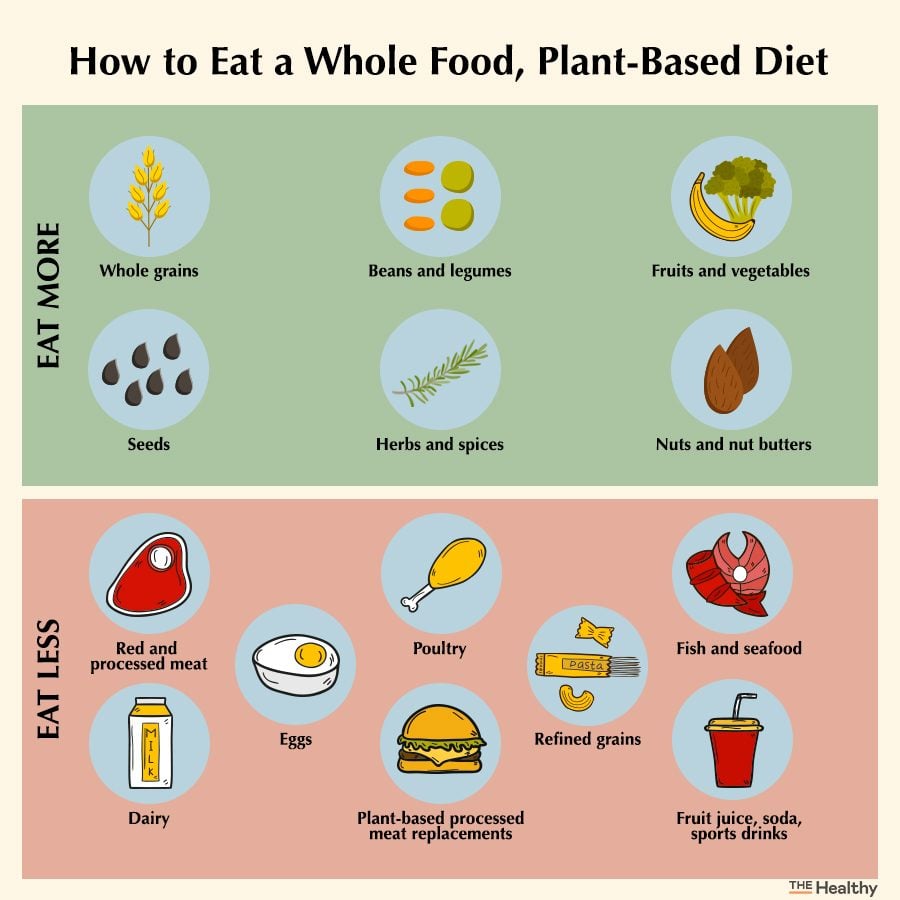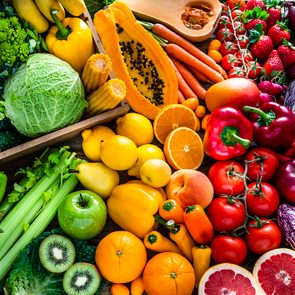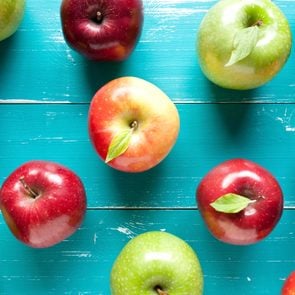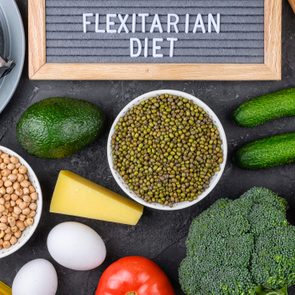How to Eat a Whole Food, Plant-Based Diet
Updated: Mar. 16, 2022
Learn how eating a diet of minimally processed plant foods can benefit your overall health. Plus, get a five-day sample menu to help you get started.
All plant-based foods aren’t the same
Plant foods are getting a lot of love these days. In some cases, maybe too much.
According to a recent International Food Information Council survey, 43 percent of people polled said that they would assume that any food labeled “plant-based” is healthier than a similar food that wasn’t made from plants, even if the nutrition labels were identical.
But are vegetarian mac and cheese and soy chorizo really as good for you as the plants they were made from?
Here’s a beginner’s guide on what to know about plant-based food trends, including how to start a whole-food, plant-based diet that’s good for your health; a food list; and a five-day sample menu to help you get started.
What is a whole food, plant-based diet?
The definition depends on who you ask, explains Linda Arpino, RDN, a registered dietitian nutritionist with offices in New York City and Connecticut.
On the most basic level, the diet is all about filling your plate with minimally processed fruits, vegetables, beans, and whole grains. However, there are several different spins on the concept.
(Check out these plant-based breakfast ideas from nutritionists.)
At one end of the spectrum, many vegans believe the diet should consist entirely of whole plant foods and exclude all animal products (even honey). On the other end, many omnivores and flexitarians see it as a way to eat more unprocessed plants that may—or may not—include some whole animal proteins. Then, somewhere in the middle, are vegetarians who say it’s all about choosing whole plant foods over processed ones, but that eggs, dairy, and fish are okay.
(Plant-based vs. vegan: here’s how they’re different.)
What makes a whole food, plant-based diet so healthy?
“Whole plant foods contain a plethora of nutrients, including fiber, protein, vitamins, minerals, fats, phytonutrients, and antioxidants,” says Taylor Wolfram, RDN, a nutrition counselor and self-care coach. “When we eat these foods, we’re getting as many nutrients as possible.”
But whole-food, plant-forward eating isn’t just about gobbling up more beans, produce, and grains. It’s also about avoiding highly processed convenience foods, even if they’re made of plants. That means no soy-based protein bars, seitan, or quick-cooking oats. And that’s just for starters. (Here’s how to add more plant-based protein to your diet.)
The reason? Processing often strips plants of many of their nutrients, explains Melissa Prest, RDN, a Chicago-based registered dietitian nutritionist and spokesperson for the Academy of Nutrition and Dietetics. At the same time, it often adds large amounts of ingredients that nature never intended, like fat, salt, and sugar, she says.
(Here’s what happens when you stop eating processed foods.)

Health benefits of eating whole plant foods
There are several potential health benefits associated with having a diet rich in whole plant foods.
Easier weight control
Fruits, vegetables, beans, and whole grains aren’t just naturally low in calories. They’re also loaded with slowly digested fiber that helps you feel full. Prest explains it this way: After eating a serving of potato chips, you can still feel hungry and unsatisfied. But if you were to eat, say, some broccoli instead, its fiber would fill you up. And because broccoli takes longer to chew, it helps you slow down and eat more mindfully.
(These are the foods with more fiber than broccoli.)
Cancer protection
There’s a reason the American Institute for Cancer Research gives plant-based eating the thumbs up. “This diet includes lots of fruits and vegetables, which are high in antioxidants and phytochemicals that protect cells from free radicals, which may play a role in cancer development by damaging cells and their DNA,” says Prest. In addition, plants are rich in anti-inflammatory nutrients that may also guard against cancer, she says.
(Learn more about the benefits of an anti-inflammatory diet.)
Better heart health
Plant-focused eating may prevent heart disease, but only if it’s made up of healthy, minimally processed foods, according to a 2017 study in the Journal of the American College of Cardiology. When researchers reviewed the diets of more than 208,000 people, they found that those who ate mostly fruits, vegetables, whole grains, nuts, legumes, and vegetable oils were 25 percent less likely to develop coronary heart disease than omnivores. On the flip side, people who favored highly processed plant foods (think French fries, chips, desserts, juice, and sugary drinks) were nearly a third more likely to have ticker troubles than the average person.
(Here are the best and worst heart health diets.)
Reduced diabetes risk
The more plant foods you eat, the lower your odds of type 2 diabetes, according to the results of a 2019 JAMA Internal Medicine meta-analysis of nine studies. However, like heart disease, whole plant foods provide greater protection than processed ones, reducing type 2 diabetes risk by 30 percent.
(These are the best foods for a diabetic diet.)
Are there any risks to a whole food, plant-based diet?
“If you’re consuming a plant-based diet that doesn’t contain any meat, poultry, or seafood, then there are certain nutrients you may not be getting enough of,” says Amy Gorin, RDN, a plant-based dietitian and recipe developer based in New York City. “These include vitamin B12, vitamin D, and the omega-3 fats DHA and EPA.”
(Find out more about potential vitamin deficiencies if you’re vegetarian or vegan.)
How much work is a whole food, plant-based diet?
True, a plant-based diet is healthier when it’s not loaded with processed foods. But not all processed foods are unhealthy.
From frozen fruits and veggies to tofu, tempeh, and canned beans, there are lots of nutritious processed plant foods that make healthy eating easier, says Wolfram, so don’t assume they’re all bad.
(Here are some high-protein plant-based meals you can try.)
Gorin agrees. “I don’t know anyone who wants to make their own whole-wheat flour!” she says. If you choose to give up these convenience foods be prepared to spend more time in the kitchen.
(These meal prep hacks can help cut down on cooking time.)

What you’ll eat in a whole food, plant-based diet
Think of these foods as the core of the diet:
- Whole grains: Brown rice, quinoa, barley, whole wheat, millet, teff, and steel-cut and rolled oats
- Beans and legumes: Chickpeas, lentils, peas, and beans like black, kidney, pinto, and cannellini
- Fruits and vegetables: Any kind (including fresh and frozen)
- Seeds: Pumpkin, sunflower, sesame (extra points for omega-3-rich chia and flax)
- Herbs and spices: Any kind goes as long as it’s free of added salt or preservatives
- Nuts and nut butters: Peanuts, walnuts, pistachios, cashews, pecans, macadamias, and their butters
- Single-ingredient condiments: Lemon and lime juice, vinegar
Some people add these:
- Minimally processed soy foods: Tempeh, tofu, and miso
- Unsweetened plant milk: Oat, soy, and almond
- Ready-made condiments: Ketchup, mustard, soy sauce, maple syrup, date syrup, and molasses
(Here are some tips on going plant-based on a budget.)
What you’ll avoid (or minimize) on a whole food, plant-based diet
- Red and processed meat
- Poultry
- Fish and seafood
- Yogurt, milk, and cheese
- Butter, sour cream, heavy cream, and half-and-half
- Eggs
- Plant-based processed meat replacements: Vegan burgers, vegan chicken and bacon, plant-based fish, and vegan sausage
- Refined grains: white flour, white pasta, white rice, and instant and quick-cooking oats
- Anything made with soy or pea protein isolate
- Fruit juice, soda, and sports drinks
How to start a whole food, plant-based diet
“Don’t try to make all the changes at once,” says Gorin. “If you’re used to eating several meat meals each day, scale back to once a day and swap in vegetarian protein sources such as eggs, tofu, and chickpeas.” Then, over time, look for more minimally processed foods and dial back on meat and poultry even more.
5-Day whole food, plant-based sample menu
Day 1
Breakfast
Plain Greek yogurt + fresh berries + chopped walnuts
Lunch
2 clementines
Snack
Apple + peanut butter
Dinner
Day 2
Breakfast
Steel-cut oatmeal + raisins + almond butter + unsweetened almond milk
Lunch
Baby kale salad with white beans, grape tomatoes, mozzarella cheese, sunflower seeds, olive oil, and vinegar
2 kiwifruit
Snack
Air-popped popcorn + Parmesan cheese
Dinner
Lemon garlic roasted asparagus
Day 3
Breakfast
Honey poppy seed fruit salad + plain Greek yogurt
Lunch
Snack
Hummus + red pepper slices
Dinner
Black bean tomato chili over brown rice
Day 4
Breakfast
Lunch
Grapes
Snack
Dinner
Portobello and chickpea sheet-pan supper
Day 5
Breakfast
Scrambled egg + whole-wheat tortilla + avocado slices
Lunch
Strawberries
Snack
Pear + Cheddar cheese
Dinner
Chickpea and potato curry + a dollop of plain Greek yogurt
The final word
“I like to think of a whole food, plant-based diet as the way nature intended for us to nourish ourselves,” says Prest. However, as healthy as it can be, it’s not perfect. So be prepared to invest a little extra thought, planning, and effort. And don’t feel you have to go it alone.
“If you want to start a whole-food, plant-based plan or are finding it difficult to incorporate minimally processed plant foods into your repertoire, a few sessions with a registered dietitian can really help,” she says.
Next, find out if vegetarian fast food is actually healthy.














